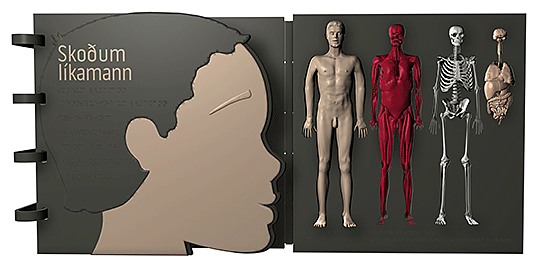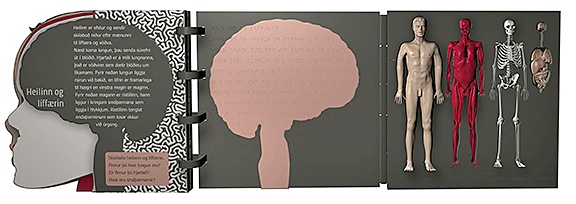by Halla Sigridur Margretardottir Haugen
From the Editor: Halla “Sigga” Margretardottir Haugen is a graphic designer, illustrator, and events planner who lives in Reykjavik, Iceland. She studied graphic design in Florence, Italy, and at the Icelandic Academy of the Arts in Reykjavik. She hopes to use her background to work in an environment where people with different educations come together to make beautiful designs that will help others. As she wrote this article, she was awaiting the birth of her second child.
"Two years ago I decided to go back to school and finish my bachelor's degree in graphic design at the Icelandic Academy of the Arts. While researching an assignment in 2011, I visited the National Institute for the Blind, Visually Impaired, and Deafblind and became fascinated with tactile graphics in books. Each tactilely illustrated book was a work of art, combining form, materials, and imagination. Most of the books I saw had some educational purpose, giving children an opportunity to learn about the world around them through raised images.
Looking farther, I found that most children's books with tactile images come from other countries. The schools in Iceland do not have many learning materials with tactile illustrations for blind children. Some books have been translated, but in the translation the meaning often changes and the images and texts do not necessarily match.
Personally, I cannot imagine how it would be possible to learn without having illustrations to explain how things work. Our whole environment comes to life when we understand its particular forms and functions. But the blind children in Iceland have no choice. They are lucky if they get one or two pictures in a whole math book.
I could not get this lack of illustrations in learning materials out of my mind. I ended up writing about tactile books for my BA thesis in the autumn of 2011. In the process I learned more about tactile books and what blind children need. I learned how the books should be designed, what is available now, and what may be published in the next couple of years. I found myself asking the same questions again and again. Can these books be made in another way? Is there a way to make the process easier and to enable the publisher to make many copies without difficulty? Is there a way that could be used for a variety of teaching materials? How could I make a book for the blind or visually impaired?
When it came to my final project I decided to make teaching materials about the human body for blind and visually impaired six- to eight-year-old children. It is possible to use almost anything to make a tactile book, but it can be hard to find enough of one material to make many books. What would be the best material to represent skin or bones? I went through a long process trying to find the best way to make my book. Finally I decided not to limit myself to technology that we use today. To broaden my horizon I talked to a lot of people with different backgrounds and tried to find a new way to make the book. During the research, the idea of using 3D printing came to me.
Additive manufacturing (AM) or 3D printing is well known to many people. It has been around at least since the 1980s. At first large printers could print out fairly simple objects, but since then there have been vast improvements. The process is now used to make many of the most complicated objects on the market today. I knew about AM but I had never given it much thought before, as I did not have the knowledge to make things in 3D programs.
Many companies print in 3D. I ended up contacting a Belgian company called Materialise because it has an extensive range of 3D printing technology. Its clients include large technological companies, hospitals, surgeons, and people like me who are interested in bringing their own designs to life. With 3D printing it is possible to print virtually anything in as many copies as you like. If I can design or model my idea digitally on a computer, it can be "3D printed" in layers of material to form a complete three-dimensional object. Objects can be made from a wide variety of materials such as hard or soft plastics; soft fluffy material similar to fake grass; or metals such as titanium, stainless steel, and silver. Researchers are even bringing new materials to the market, enabling people to print out gold, concrete, wood, bone, human cells, and much more.
When I learned about these possibilities, I knew this was how I wanted to make my book. With 3D printing I had the opportunity to make a book with both 2D and 3D images. The idea fascinated me, and I wanted to see if I could make something that could be used to help blind children.
At that stage of the project I had no idea how to work in 3D programs, so I had to start from the beginning. I had to find a program that suited my needs, then sit down and learn to use it. Once I had some anatomical models of the human body and a relatively good knowledge of the program, I could start to design the book itself. The design changed numerous times during the process, but today I have a white prototype in 3D and a 2D color version of my book. The original final design cannot be executed today in exactly the way I intend, as I decided to design the book without limitations. I tried to think beyond the frame of current possibilities.
I always knew it would be hard to print out the human body exactly as it is, but it can be produced from materials that have a density and texture similar to the skin, muscles, bones, and inner organs. Why focus on what we have now, when there is progress in the field every day? Who knows what will be available in a few years? The technology exists, and in the end I hope to make something that will be even more useful for the children. If there is a demand, the technology will follow. I am happy to say that at this moment people are working out how to print the book in a cost-effective way with as many of my desired details as possible. We will see what I have in the end.
Through the whole process I have been looking at materials created earlier for blind and visually impaired children. To my surprise, I have not found any learning resources made with this 3D printing technology. There are endless possibilities. The only limits are those within our imaginations. For example, it will be possible to enhance the experience of art exhibits. Replicas of paintings and sculptures can be printed in 3D so that anyone can touch them. With the materials available today, almost anything can be reproduced with a density or texture similar to the original. Objects that are too fragile to be handled or things that are too large or small to be understood by touch can be printed in more durable materials or in different proportions. It should be fairly simple to print maps of neighborhoods on a feasible scale. Imagine being able to feel the shapes of neighboring houses, to discover how many trees there are along this or that road, or to learn what your own house looks like from the outside! Imagine a tactile picture of the view from your window! It will also be possible to print the world as blind people experience it, to help sighted people understand it better and link these differing perceptions.
Today the greatest barriers to making 3D printed learning materials are the cost and the learning curve involved with 3D design programs. These factors will not always stand in the way. The companies that print in 3D are becoming more aware of the private consumer. Printers for private homes have entered the market, and the materials are becoming cheaper. In the near future it will be easier to design in 3D with the help of programs such as SketchUp from Google, which is already available. Other programs are on the way. Some AM companies have developed simple programs that are specifically designed for their printers.
My advice is not to limit yourself to what is already available. Make designs that can and will be used in the future. If I can do this, anyone can! It is just a question of how much you want to make it happen.
Making the book Discover the Body has been a long and adventurous process, and it has been one of my greatest challenges in design so far. I have been lucky to meet and know new people who have been ready to help me make this product, which I hope will be a great help to the children.
Since I graduated four months ago, my book seems to have taken on a life of its own, receiving attention from all over the world. People from Europe, the United States, and Australia have been in touch with me to learn more about Discover the Body.Some want to buy the book. Others publish articles about it, introduce it at conferences, and even show it in art exhibitions. I never thought that a BA project could get so much attention, and it fills me with overwhelming gratitude.
All of this interest tells me that I am doing something right. Creating 3D access to the world for blind and visually impaired people is one of my dreams, no matter what form the connections may take. I think that only good can come from this pursuit. It is just a matter of having an open mind, following the technical developments, and using each step to the best advantage. I hope that in the end the whole process of making this book will do some good in the future, no matter how long it takes."




















































